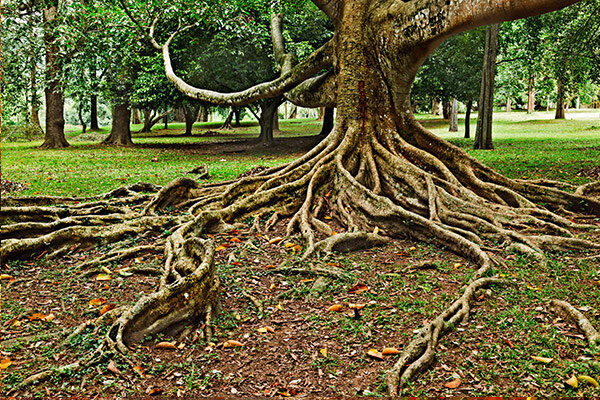Getting to the Root of Your Tree Problems
Tree roots – you have a love and hate relationship with them. You love them because they make your tree taller and stronger than you ever thought possible. They help your tree to get the nutrition that they need and they help it to stand tall in the face of in-climate weather.
However, roots have another huge responsibility: they can tell us what is happening with our trees. Roots act like a tell-all when there are problems within the tree itself – problems that you might not be able to spot any other way.
4. Annosum Root Rot
- Most common disease plaguing trees
- Extremely easy to spot, not as easy to eliminate
- May require professional help
If you see mushrooms around your garden or yard, they might not be innocuous. Instead, they could be a sign that something far more sinister is going on: annosum root rot. This disease is more common in areas with sandy soil, but it can be found anywhere.
To spot this, look toward the roots to find resin soaking or to find white, stringy tissue left over. Eventually, the roots will weaken and the tree might start to lean or wiggle in storms. You might also find reddish brown conks near the bottom of the tree.
According to the University of Maryland, “White fans of fungal growth, and dark brown shoestring-like threads called rhizomorphs, may be found under the bark at the base of infected plants, or on the roots. The fruiting bodies that form from these fungi can be fleshy mushrooms that appear annually or hard shelf-like structures that grow a new layer each year as the rot progresses. As a result of the fungal infection, the root system is reduced and dark brown.”
3. Phytophthora Root Rot
- Similar to annosum root rot
- Occurs in wetter climates
- Starts in springtime
Similar to annosum root rot, Phytophthora Root Rot is far more common wetter environments where rainwater and other water cannot drain. The syptoms start with a “soggy” appearance and reduced candle elongation – usually in the springtime. After that, they needles start to wilt and begin to fade in color. Eventually, the roots, bark, and wood become spongy and have resin. Exposed roots will be covered in resin. Trees in wet regions are very susceptible to this, especially if the soil was wet when the trees were planted.
According to Missouri Botanical Garden, this disease hits ornamental trees far more commonly. It is also important to know that the disease itself can exist in soil for a long time, meaning that you can pass it on to trees that have been planted where ones who were killed by the disease reside.
2. Root Damage
- Can be caused by anything
- Particularly susceptible in young trees
- Can lead to root loss
Root damage can occur from anything – from kicking it with a shoe that has a sharp edge to cutting it with the lawn mower to bruises in storms. When the root is damaged, the tree does not have the ability to get water and nutrients in the same way. If the damage is too bad, the root can die and too much root loss leads to the death of the tree. Typically, a tree has to lose 50% of its roots to see an impact, but smaller trees only need to lose around 25% to impact growth and development.
According to Home Guides, “Wilting is an obvious sign of root damage, caused by the plant’s inability to take up any soil moisture. Other significant signs are premature leaf drop and yellowing; conifers may drop most of their inner needles. Leaf scorch can develop when roots can’t pull up moisture from the ground fast enough to match the leaf evaporation rate, another telltale sign of root damage.” You might also want to look for thinning in the foliage as well as dead branches. Even though it is the furthest point from the roots, you will see the impact in the crown first and foremost, and then it will move down the tree.
1. Butt Rot
- Often leads to tree death
- Failure of roots
- Tree may fall
A funny name for a serious disease, butt rot isn’t talked about often but is very dangerous. Forest Pathology says that the signs of butt rot include, “Failures of roots or snapped stems have evidence of decay on the broken surface (brash failure, breaks easily across the grain), even long after the failure and after subsequent decay occurs.”
If you see these signs, it is important to act quickly as this disease can quickly kill your tree – and it likely won’t stay standing. The roots are compromised and the tree becomes extremely top heavy, meaning winds that are slightly above normal can bring it down quickly. Make sure to inspect your tree for any of those signs, as well as stem failure, particularly on the lower half of the tree.
Reading your roots is just one way to tell if you have a problem with your trees. There are many other signs that something could be wrong – or they may be none at all. Knowing the signs to look for can help you to get help when you need it.
If you believe that you have a problem with your trees or in your yard, give us a call today at (269) 216-6811 and we can set up a time to visit you and your beautiful trees to see just what the problem is – and how we can help you. Even more, if you have been facing issues with your trees and you just want to make sure that they have the best chance of survival into the next season, contact our professionals. There is no job too big or too small.


